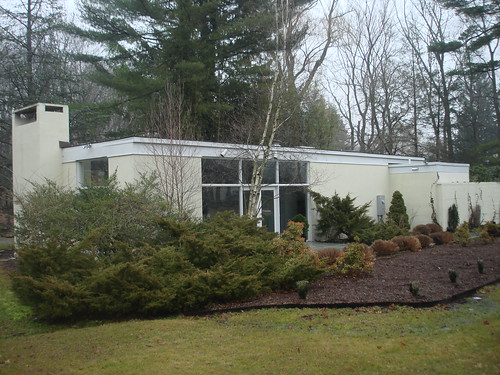
One of the first families of European descent to settle in our town was named Fancher. There are still some Fanchers around, and one of the older roads in town is called Fancher Road. On a small knoll at one of its bends is a saltbox house that, we think, was a Fancher house, although Fanchers haven't lived in it for decades.
It is small and, from the outside, nicely proportioned. Until recently it was painted a light yellow. Then it went on the market and was sold within the last year. Excavation work began at the rear of the house, and the shell of what appeared to be a classic modern house began to take shape. That's not all that unusual -- people around here buy small old houses all the time and then expand them, and the additions often look in their early days like modern houses, until the peaked roofs and clapboard and fake shutters go on.

But the peaked roof and clapboard and fake shutters never went on this house. The flat roof stayed. The sides, instead of clapboard, revealed themselves to be glass alternating with gray fieldstone. The salt box had a new portico added to the front and was painted a light bluish-gray and then, within the last couple of weeks, a brownish red.
We haven't done any research yet. But it's been interesting to watch. Pound Ridge is known for its modern houses -- modest compared to the masterpieces next door, in New Canaan, but in some ways nicer for the way they fit into the landscape. Ours was built in 1939 and was one of the first dozen of so, probably, ever built in Westchester County.

At last year's New Canaan Historical Society Modern House Day, architect Peter Gluck said he did not know of one modern house being built in the metropolitan area. Further up Fancher Road, where the name changes to Barnegat Road, a friend of ours is building a modern house (and doing it himself). And now there's this one. We also have a strong local history. As I mentioned, some Fanchers still live in the area, and on one stretch of nearby road the descendants of two of the families that founded the town in the 1720s still live with half a mile of each other.
This house manages to combine the historical and the modern in a way we like (although I'd be surprised if some of our neighbors aren't grumbling: when our friend on Barnegat was before the Planning Board for approval, one philistine on the board compared his house to a double-wide trailer).

As I said, we haven't looked into it much yet, but when we get a chance we'll go to the building department, find out the name of the architect and report back. It's been fun to watch it being built and it'll be fun to see how it ends up. - ta

 Although I have absolutely no numbers with
Although I have absolutely no numbers with  which to back up my hunch, I would bet that dressing up a trailer – or drastically modifying it as the case seems be with the TrailerWrap Project – isn't going to be any less expensive than building a modest little modern house from scratch.
which to back up my hunch, I would bet that dressing up a trailer – or drastically modifying it as the case seems be with the TrailerWrap Project – isn't going to be any less expensive than building a modest little modern house from scratch.
 Marcel Breuer wrapped his trailer way back in 1949 or so. His Wolfson Trailer House surrounds a 1948 Royal Mansion Spartan Trailer, which serves mostly as the house's kitchen and dining area. I think the house and studio on 10 acres in Duchess County, NY, is still for sale by our friend, the painter David Diao. – GF
Marcel Breuer wrapped his trailer way back in 1949 or so. His Wolfson Trailer House surrounds a 1948 Royal Mansion Spartan Trailer, which serves mostly as the house's kitchen and dining area. I think the house and studio on 10 acres in Duchess County, NY, is still for sale by our friend, the painter David Diao. – GF





